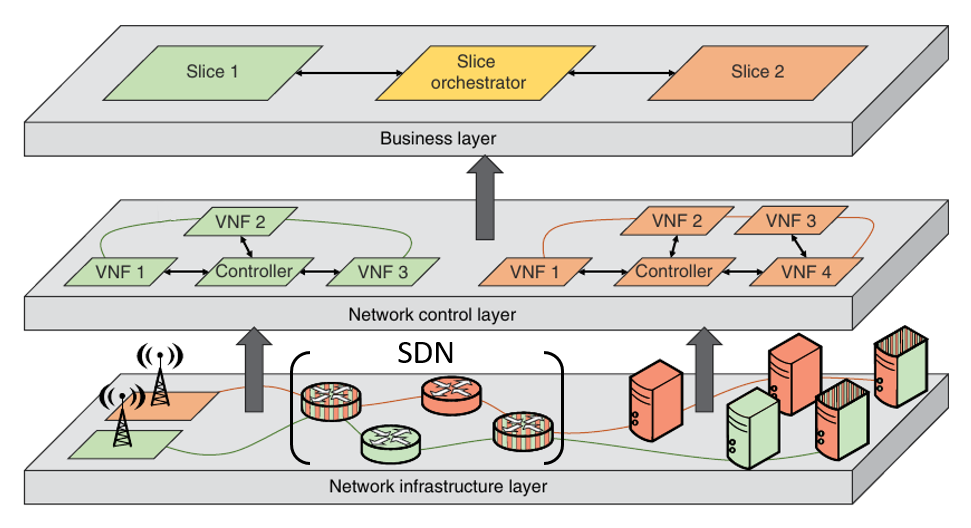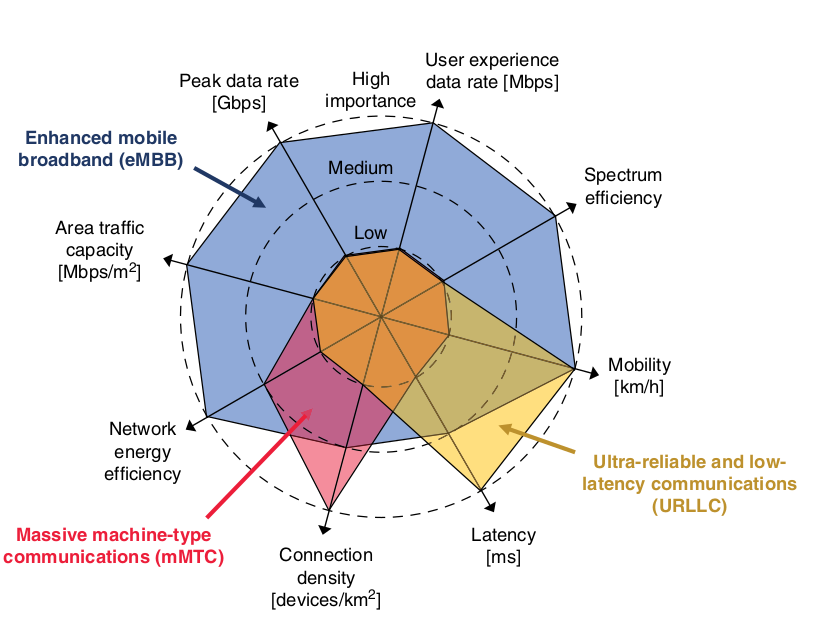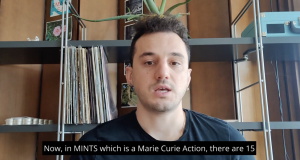Published on: Mar 25, 2022
Network slicing is one of the promising innovations to push forward the frontier of 5G and beyond mobile communications. It permits Mobile Network Operators (MNO) to share their physical infrastructures for simultaneous deployment of multiple independent logical networks, each managed with respect to their specific service requirements. Different services, such as automotive, tactile internet, or massive IoT, can simultaneously operate by exploiting different network slice instances in the form of virtual network functions that run on the same infrastructure with customised policies. In this way, heterogeneous services can run on the same infrastructure since different instances can be orchestrated and set independently according to the requested specifics. Furthermore, this can be executed cost-efficiently because a network slice shares the same physical infrastructure with other slices.

Fig. 1: An example of a network-sliced architecture. [1]
The introduction of Software Defined Networks (SDN) and Network Function Virtualization (NFV) has revolutionized 5G. SDN separates routing decision-making processes (Control Plane) from the packet forwarders that implement routing decisions (Data Plane). The separation of the control plane functions from the user data plane forwarding functions has contributed to a parallel and complementary concept of ‘software-ization’ of functions. The result is that dedicated devices that are difficult to upgrade have been replaced either by general hardware devices, whose actions can be rapidly changed by easily upgradeable centralized control software, or by fully implementing the function in software running on general-purpose computing servers. This shift towards software running on commodity compute servers is referred to as NFV [7]. Fig. 1 summarizes the conceptual design of the 5G network: in the Network Infrastructure Layer, SDN decouples the data plane which comprises of commodity routers, switches and servers, from the control plane. This plane has become independent from the underlying hardware and it is now part of the Network control layer where Virtualized Network Functions can be run. Services such as NAT, encryption, firewalls, DNS, are not carried out on dedicated and proprietary devices anymore, but in this layer thanks to virtualization. Finally, on top, the slices are realized, and they can be thought of as isolated networks tuned for specific use cases.
Previous telecommunication generations hosted different services such as mobile broadband, voice, and SMS over the same network architecture. Thanks to the slicing feature, 5G will be able to leverage shared and customized logical architectures to fulfill the requirements of vertical services like Enhanced Mobile Broadband (eMBB), vehicular communications, Ultra-Reliable Low-Latency Communications (URLLC), and massive Machine-Type Communications (mMTC). These slices are standardized in [6] and their characteristics are:
- Enhanced mobile broadband (eMBB): it is an evolution of 4G network, related to the operations performed by the common users in our daily life. It targets to enhance access to multimedia and to give services an improved performance by increasing the quality of experience. It also has to cope with contrasting situations, that is to serve both a restricted high-density user area with huge traffic and poor mobility of users, while also providing wide-area coverage with medium or high user mobility. Moreover, 5G aims to provide complete coverage everywhere with a guaranteed data rate of 50 Mbps and a peak data rate of 20 Gbps.
- Ultra-reliable and low-latency communications (URLLC): this is the most suitable slice when the requirements for latency and reliability are very strict. It will play a fundamental role in Industry 4.0, and indeed involves applications such as remote medical surgery, automation industries, and smart grids.
- Massive machine-type communications (mMTC): it is the realization of an efficient Internet of Things, where a huge number of devices are connected, transmitting a low volume of data traffic, usually non sensitive with a delay which can be seconds or hours. In general, these devices must be low-cost with a long battery-life. Some examples are logistics applications, smart metering, and agriculture where a lot of sensors are spread-out to collect data.
Fig. 2 highlights the KPIs for each slice.

Fig. 2: Division of capabilities for each slice. [1]
To wrap it up, in this blog post we described one of the key innovative features of 5G, the network slicing. We started by explaining its enabling technologies and their importance, then concluding by enunciating the benefits it will unlock for several use-cases.
If you were able to stick until the end and can’t wait for more content and you also want to know about us and our projects, you can always follow our social media channels.
Citations
[1] A. Al-Dulaimi, X. Wang, and I. Chih-Lin, 5G networks: fundamental requirements, enabling tech- nologies, and operations management. John Wiley & Sons, 2018.
[2] P. Marsch, O . Bulakci, O. Queseth, and M. Boldi, 5G System Design: Architectural and Functional Considerations and Long Term Research. John Wiley & Sons, 2018.
[3 P. Popovski, K. F. Trillingsgaard, O. Simeone, and G. Durisi, “5g wireless network slicing for embb, urllc, and mmtc: A communication-theoretic view,” arXiv preprint arXiv:1804.05057, 2018.
[4] J. Ordonez-Lucena, P. Ameigeiras, D. Lopez, J. J. Ramos-Munoz, J. Lorca, and J. Folgueira, “Network slicing for 5g with sdn/nfv: concepts, architectures and challenges,” arXiv preprint arXiv:1703.04676, 2017.
[5] P. Ohlen, B. Skubic, A. Rostami, M. Fiorani, P. Monti, Z. Ghebretensae, J. Martensson, K. Wang, and L. Wosinska, “Data plane and control architectures for 5g transport networks,” Journal of Lightwave Technology, vol. 34, no. 6, pp. 1501–1508, 2016.
[6] ETSI, “3gpp ts 23.501 v15.2.0,” 2018.
[7] Kevin Sparks, Marvin Sirbu, “5G Network Slicing Whitepaper,” 2018.





